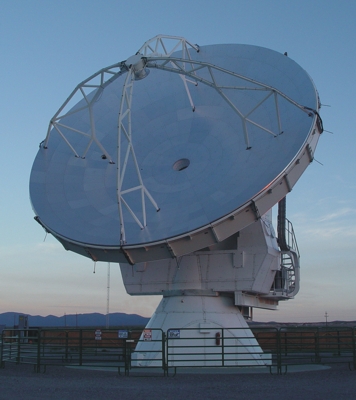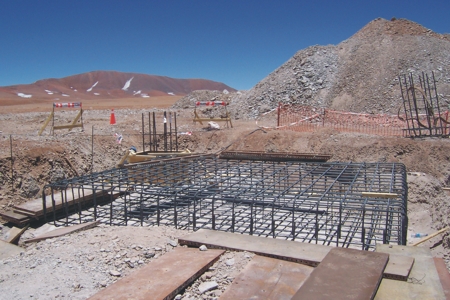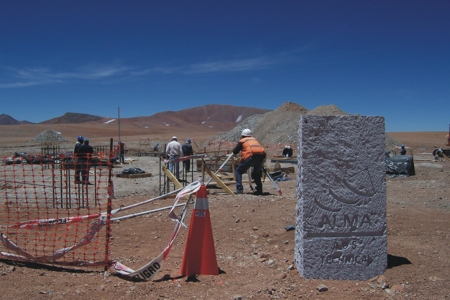ALMA NRAO News January 2006
ALMA News from the January 2006 Issue of the NRAO Newsletter
ATACAMA LARGE MILLIMETER ARRAY
NAASC Workshop From z-Machines to ALMA: (Sub)millimeter Spectroscopy of Galaxies
On January 13-14, 2006, the North American ALMA Science Center (NAASC) at NRAO will hold a workshop in Charlottesville, Virginia, on (sub)millimeter spectroscopy of high-redshift galaxies. In the last decade, deep imaging from infrared through radio wavelengths has revealed important populations of distant, dusty galaxies with high rates of star formation and/or accretion. Multiple efforts are now underway to build dedicated, wide-bandwidth instruments ("zmachines") that can directly determine molecular emis-sion-line redshifts for obscured sources that cannot be easily studied at optical/near-IR wavelengths. The workshop goals are:
- to inform the community of the new generation of wide-bandwidth (sub)millimeter spectrometers;
- to discuss the key scientific questions about dusty high-redshift galaxies that z-machines can address in the near term; and
- to consider how observing programs with z-machines can optimize exploitation of ALMA's unique capabilities on longer timescales.
The presentations at the workshop will be published in the Astronomical Society of the Pacific (ASP). Serving on the Scientific Organizing Committee are Andrew Baker (chair, NRAO/University of Maryland), Andrew Blain (Caltech), Neal Erickson (University of Massachusetts), Xiaohui Fan (University of Arizona), Jason Glenn (University of Colorado), Eduardo Hardy (NRAO), Andrew Harris (University of Maryland), Gordon Stacey (Cornell), Paul Vanden Bout (NRAO), and Min Yun (University of Massachusetts). John Hibbard is chairing the Local Organizing Committee. The final program and list of participants are available at
http://www.cv.nrao.edu/naasc/zmachines/.
A. Baker, J. Hibbard, P. Vanden Bout
ALMA Town Meeting
ALMA will hold a Town Meeting at the winter meeting of the American Astronomical Society, January 8-12, 2006 in Washington, D.C. The Meeting will take place on Monday, January 9 from 12:30 - 1:30 p.m. in the Cotillion Ballroom. The purpose of this Town Meeting is to inform the AAS membership of the status of the ALMA Project, present the power of ALMA for its key areas of science, and summarize the services ALMA users can expect from the North American ALMA Science Center (NAASC). Ample time has been allocated for answering questions from the audience.
The January AAS meeting will also feature special sessions for the Herschel Space Observatory, the Sub-Millimeter Array (SMA), and the Expanded Very Large Array (EVLA). These should be of interest to all potential ALMA users.
H. A. Wootten and P. Vanden Bout
North American ALMA Science Center
The NAASC staff continues to make progress preparing for ALMA's operational phase, including work on the organizational and staffing plan and by participating in tests of critical ALMA elements, such as the proposal tool, the pipeline system, and the off-line data reduction software. Key tests are planned in this area in the first quarter of 2006, as is an internal review of the NAASC Operations Plan. Progress has started on developing a spectral line database for use with the ALMA observing tools and a millimeter calibrator database. More information on the NAASC is available at http://www.cv.nrao.edu/naasc/.
An application was filed with the American Astronomical Society (AAS) for a Special Session at the 2006 summer meeting of the AAS, to be held in Calgary, Canada. The topic will be Star Formation from the Milky Way to Cosmic Dawn, to be held on the first day of the meeting, which is to be held jointly with the Canadian Astronomical Society (CASCA).
The ALMA North American Science Advisory Committee (ANASAC) is composed of representatives of the wider North American astronomical community who provide scientific advice on the operation of the NAASC. The ANASAC met via telecon on October 18, 2005. The committee discussed the results of the recent ALMA Cost Review and the NSF Senior Review. A letter emphasizing the scientific importance of a 50-element or larger array was written and sent to the NRAO Director. The next ANASAC telecon is scheduled for January 6, 2006. Community members who are interested in a listing of the ANASAC membership and dates of scheduled meetings are given at http:// www.cv.nrao.edu/naasc/admin.shtml.
Paul Vanden Bout
ALMA Project Status
Until recently, the Joint ALMA Office (JAO) staffing lacked a Project Scientist to be complete. This lack has now been remedied. Until late 2007, the three current Project Scientists (A. Wootten, NA; T. Wilson, ESO; and R. Kawabe, NAOJ) will also perform the JAO Project Scientist duties, each for four month terms, under an agreement on an interim arrangement reached by the JAO, ESO, AUI/NRAO, and NAOJ. The interim JAO Project Scientist will act from the JAO offices in Santiago. This arrangement will continue until late 2007 when it is expected that recruitment of a Project Scientist will be facilitated by the beginning of antenna deliveries and commissioning. It has been my privilege to inaugurate this rotation, to be followed in the new year by T. Wilson and R. Kawabe, respectively. If your plans bring you to Santiago, please visit us!
The last four months have been busy. All ALMA elements have reached a state of technological readiness and are being assembled at the ALMA Test Facility in New Mexico in a prototype system integration phase. Five years ago, ALMA was a "must do" scientifically but with high technical risk pushing the state of the art. ALMA now has:
- prototype antennas that meet ALMA's demanding requirements: Vertex antennas for ALMA and APEX have 15 - 16 µm surface accuracy, and offset pointing to 0.6" accuracy; receivers with near quantum-limited performance, unprecedented bandwidth and no mechanical tuning: 1.3 mm preproduction receiver has SSB receiver temperature less than 50K;
- receivers with near quantum-limited performance, unprecedented bandwidth and no mechanical tuning: 1.3 mm prepoduction receiver has SSB receiver temperature less than 50K;
- completed the first quadrant of the correlator below cost and with enhanced performance: ALMA data processed at 1.6 ×1016 operations per second.

This process resulted in an updated ALMA budget being issued by the JAO on September 8. The rebaselined budget was considered by the European funding agency, the ESO Council, at a meeting September 29 30 resulting in a resolution declaring that ESO Council "reaffirming the strategic importance of ALMA, and its determination to ensure the scientific success of ALMA for European astronomy and its commitment to ALMA in collaboration with its partners in North America and Japan, ... decides that the estimated increase … in the cost to completion of the ESO share of the bilateral ALMA project is affordable and compatible with ESO's strategic priorities." The National Science Board will meet November 30, 2005 as a first step to determining the level of additional funding which might be available from NSF.
These events were followed by a face-to-face meeting of the ALMA Science Advisory Committee in Santiago on October 1 - 2 to offer advice on charges from the ALMA Board. One of these charges was to consider various possible reductions in scope to reduce the ALMA budget, and to offer advice to the Board on their implementation. On October 13 - 16, an ALMA Cost Review Committee (CRC) met in Garmisch-Partenkirchen, Germany to review the cost of the re-planned project. The Committee consisted of 19 independent members with broad areas of expertise ranging from ALMA science and technology to project management. It was chaired by Steve Beckwith (JHU) and co-chaired by Thijs de Graauw (SRON). The Report on the Review of Costs for ALMA was delivered to the ALMA Board in November. This independent review has validated the new baseline project cost. The review also declared the technology readiness of ALMA very high and judged that most technical risk has been eliminated. As multiple vendors for the ALMA antennas seemed assured, the Board asked the JAO to determine how the Project would assess the additional cost of supporting two different antenna designs. The budget reviewed by the CRC did not take into account any possible additional costs. Therefore a review of this adjusted cost, a delta Cost Review will be conducted in Washington D.C. in January. NSF will be conducting an AUI/NRAO management review of the ALMA project in association with the delta Cost Review.
Back in Santiago, the AUI Board of Trustees met, followed by an excursion to see the construction progress at the ALMA site. This meeting was followed by the face-to-face meetings of the ALMA Executives and of the ALMA Board, October 31 - November 2. In October, ESO had informed the Project that it was ready to proceed with procuring its share of the ALMA production antennas. At the Santiago meeting, the Board concurred with the recommendation of the ALMA Director that ESO proceed toward issuance of a contract to procure its share of antennas. The Board also approved reductions of just over $17,000,000 (Y2K) to project scope, taking into account the advice of the ASAC and science team to maintain ALMA's scientific abilities. While the Board reiterated the ALMA scope of building sixty-four 12m antennas, the new budget acknowledges the need for additional funds to reach this goal. Meanwhile, the addition of the antennas brought by Japanese partnership allows the scientific scope to be maintained, and improves the imaging capability as well as the frequency range of the final ALMA telescope.
Negotiations between the European Executive and its prospective contractor resulted in a contract being signed on December 6, 2005 to provide up to 32 production antennas. With two major antenna contracts signed, and signing of another imminent, the focus moved toward timely completion of the Project. (A contract for refurbishing the NAOJ prototype, and for the twelve 7m antennas of the Atacama Compact Array (ACA) will be finalized by the end of 2007). A manufacturing readiness review of three of the 12m antennas comprising the ACA was held in Osaka, followed by a review of the ACA System in Mitaka. These 12m antennas and the first of those contracted by NRAO/AUI will arrive in Chile during 2006.
Construction of the infrastructure necessary to support ALMA has reached an advanced state. The 43km ALMA road, passable already at the ALMA groundbreaking on November 6, 2003, will be finished within a few months. The 2900m altitude ALMA Camp sleeps and feeds ALMA personnel in its 30 bed facility while the Contractor Camp can now bed and feed 120 to 200 supervisors and workers with offices and recreational facilities. ALMA personnel will move to the future Operations Support Facility, now in the final stages of bid evaluation. Excavations have begun for the Technical Building at the 5000m altitude Array Operations Site. John Conway, Mark Holdaway and collaborators have produced a new design for the ALMA configurations, optimized for staged deployment of up to 64 antennas. The construction of the first antenna pads is scheduled to start in early 2006. Later this year the first production antenna will arrive at the Contractor's camp for assembly before it moves to the project testing area early in 2007.
Meanwhile in Washington, Congress expressed its appreciation for the progress in construction by fully funding ALMA for the eighth consecutive year.
Alwyn Wootten

Figure 1. Construction on the Technical Building at the Array Operations Site. This building will house the ALMA correlator, local oscillators, and all local hardware.

Figure 2. Construction site with the ALMA corner stone in the foreground.




Connect with NRAO